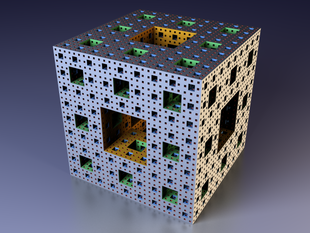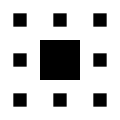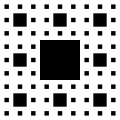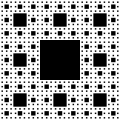Menger sponge
The Menger sponge (also: Menger curve ) is like the Sierpinski triangle and the Koch curve to the objects of the fractal geometry . The sponge named after Karl Menger was first published in 1926 in his work on the dimensionality of point sets . The Menger sponge is a three-dimensional analogue of the Cantor set or the Sierpinski carpet .
Formal definition
Formally, a Menger sponge M can be defined as follows:
where M 0 denotes the unit cube and
construction
If you transfer the construction principle of the Sierpinski carpet to a cube , you get a structure that resembles a sponge.
To construct a Sierpinski carpet, a square (and then, analogously, each of its sub-squares) is broken down into sub-squares, after which one of these 9 sub-squares is removed, which leads to the following results in the first five iteration stages:
Analogously to the construction of a Menger sponge, a cube (and subsequently each of its sub-cubes) is broken down into sub-cubes in each iteration step, whereupon seven of these 27 sub-cubes are removed again. In summary, the construction specification of the Menger sponge can be formulated as follows:
- The starting point is a dice.
- Each surface of the cube is divided into nine squares, these divide the cube into 27 smaller cubes, similar to the Rubik's Cube .
- Every cube in the center of each surface and the cube inside the large cube is removed. What remains is a perforated cube, which consists of 20 cubes, each with the volume of the starting cube . This is how the new cube of the first order was created.
- Steps 1-3 of this procedure are applied to each remaining smaller cube.
The successive continuation of this process leads to a further hollowing out of the cube with each iteration step. If you continue the process indefinitely , the result is the Menger sponge fractal .
In general, it applies to the Menger sponge that after iterations it consists of individual cubes of the corresponding iteration level. In other words, you get 20 copies of the cube when you reduce the size to a third. The side of the cube that is hollowed out depends on the iteration . The volume for the nth cube is derived from this. By the constant erosion of the volume converges in the limit to zero, while the surface of striving towards infinity. The speed of convergence is comparatively fast; From the 16th construction step onwards, only 1% of the volume of the unit cube M 0 is available.
The exact value of the Hausdorff dimension of the Menger sponge results from the definition:
Thus the "body" of Menger sponge has a Hausdorff dimension is less than 3 (as opposed to non-fractal, in fact 3 -dimensional bodies ), while its surface a Hausdorff dimension greater than 2 has (in contrast to 2 - dimensional surface of non-fractal bodies). In other words: the Menger sponge is a structure that has a “crooked” (fractal) dimension that lies between a two-dimensional surface and a three-dimensional cube.
properties
Each face of the Menger sponge is a Sierpinski carpet; in addition, the intersection of the structure with a diagonal or center line of the side surface of the unit cube M 0 gives the Cantor set . As the intersection of closed sets, the Menger sponge is a closed set from a topological point of view , and according to Heine-Borel's coverage theorem , this is also compact. It is also uncountable and its Lebesgue measure is 0.
Menger showed in 1926 that the Lebesgue cover dimension of the sponge is equal to the corresponding curve . It is therefore a so-called spatial universal curve and is able to represent all curves with a dimension ≥3 (→ homeomorphism ). For example, it can be used to embed geometries of loop quantum gravity in a Menger sponge.
The Menger sponge has a self-similar structure.
universality
The Menger curve is the universal curve; H. any one-dimensional compact metric space can be embedded in the Menger curve .
Meaning in group theory
In geometric group theory , for each finitely generated group, a metric is defined on the Cayley graph and, if the group is word-hyperbolic , the “ edge at infinity ” of the graph. Many properties of finitely generated infinite groups can be derived from this boundary in infinity.
Dahmani, Guirardel and Przytycki have shown (building on the results of Kapovich and Kleiner ) that in a certain sense almost all finitely generated groups have the Menger sponge as their edge.
In order to formulate this result precisely, one first needs the concept of “overwhelming probability”. This is defined as follows. For a number with , consider all groups with generators and (at most) relations of length (at most) . A characteristic applies (for the selected one ) with overwhelming probability if the following applies to each : for the proportion of groups with the characteristic is close to 100%.
With this definition one can then formulate and prove probability statements about groups. Gromow has proven that with an overwhelming probability one gets the trivial group or Z / 2Z (the group with 2 elements). Therefore, in the theory of random groups, one only looks at the case .
For one gets after Gromov with overwhelming probability a hyperbolic group with cohomological dimension and therefore one-dimensional edge.
For one-dimensional borders of hyperbolic groups there are only 3 possibilities according to a theorem of Kapovich-Kleiner: the circle, the Sierpinski carpet or the Menger sponge. According to the results of Kapovich-Kleiner and Dahmani-Guirardel-Przytycki, the first two possibilities do not occur “with an overwhelming probability”, which is why in the only interesting case the edge is with an overwhelming probability a Menger sponge.
literature
- Karl Menger: Theory of Dimensions , BG Teubner Publishers, Leipzig 1928.
- Karl Menger: About the dimensionality of point sets (first part) in the year 1923 monthly books for mathematics and physics (booklet 33), pages 148-160. doi : 10.1007 / BF01705597
- Karl Menger: About the dimensionality of point sets (second part) , in 1926, monthly books for mathematics and physics (booklet 34). doi : 10.1007 / BF01694895
- Benoît Mandelbrot : The fractal geometry of nature . Birkhäuser Verlag Basel, Boston, Berlin 1991, ISBN 3-7643-2646-8 .
- François Dahmani, Vincent Guirardel, Piotr Przytycki: Random groups do not split . Math. Ann. 349 (2011), no. 3, 657-673, ( online )
- Michail Kapovich, Bruce Kleiner: Hyperbolic groups with low-dimensional boundary . Ann. Sci. Ecole Sup. (4) 33 (2000), no.5, 647-669, ( online )
Web links
- Menger Sponge - by MathWorld (engl.)
- Institute for Visualization and Interactive Systems - Menger-Sponge
- 3-D model of the Menger sponge for interactive turning
- Menger sponge modification for minetest
- Interactive modeling and calculation of the Menger sponge
Individual evidence
- ↑ D. Pagon, Fractal Geometry - An Introduction , Vieweg (2000), ISBN 3-528-03152-2 , p. 22
- ↑ Mandelbrot: The fractal geometry of nature , page 156


















![O_ {n} = {\ tfrac {1} {9}} \ cdot \ left ({\ tfrac {20} {9}} \ right) ^ {{n-1}} \ left [40 + 80 \ left ( {\ tfrac {2} {5}} \ right) ^ {n} \ right]](https://wikimedia.org/api/rest_v1/media/math/render/svg/8cf5bb8d42dcd5d39a15b5e609e6db3e21005207)










